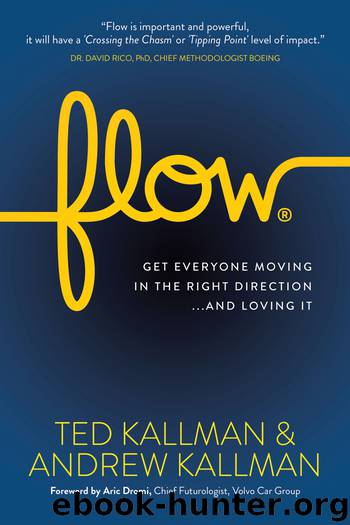Flow by Ted & Andrew Kallman

Author:Ted & Andrew Kallman [Ted & Andrew Kallman]
Language: eng
Format: epub
Publisher: Morgan James Publishing
Published: 2018-03-18T04:00:00+00:00
“Implementing continuous self-improvement requires a fundamentally different kind of mindset from traditional management. It involves creating an environment in which the organization draws on the full talents and capacities of the people who work there. It means generating a context in which workers want to improve and are given the means to do so, so that they do evolve into a high-performance mode. It’s about powering up the internal energy of teams so that they transcend their limitations and create products or services that generate client delight.” 107
STEVEN DENNING
Many studies have shown that, regardless of the type of Agile approach used, almost half of Agile teams do not use retrospectives. We believe that this is because the teams were never trained in effective retrospective facilitation. Or, they do not fully understand the power these meetings release or fully see the value. Other times it is the result of senior management not understanding the value and/or not wanting the team to waste time on the activity, thus preventing the teams from allocating the necessary time. Finally, we rarely find any team actually performing retrospectives using Vision as the lens. If the retrospective is not filtered through the lens of the True Vision, then it can be rendered meaningless even if it is conducted. Obviously, the organization loses in all of the above scenarios.
Even teams conducting retrospectives can fall into a rut of “he said-she said” finger pointing and thus not focusing on true, continuous team or organizational self-improvement. Steven Denning observes that high-performing retrospectives require a particular mindset:
“Continuous self-improvement is not a bunch of low-level production techniques to eliminate waste at the factory level. It’s a deeply rooted set of values and attitudes focused on fixing problems as soon as they occur.” 108
Another reason that we have found that retrospectives fail to Deliver the intended value, is when teams focus on proxy variables instead of Vision. Maintaining a focus on Vision is not the natural default mode for anyone apart from the person holding the ultimate Vision. Because of this truism, teams will focus on the functional aspects of the project or increment on which they are working.
If their effort is focused on improved cycle time, for example, and the improvement does not Deliver value for the True Vision, then it is a proxy variable. If it does Deliver value, then focusing on cycle time is a true variable. Spending time improving proxy variables is oscillating, not truly iterating and can lead to unproductive or failed retrospectives. Retrospectives, done well, help eliminate division and point teams to higher levels of productivity.
At an Enterprise level, an excellent tool for retrospectives for determining team and organizational health are a set of radars from Sally Elatta and her team (see http://agilityhealthradar.com/radars/) available from Agile Transformations Inc. The Growth Items that are a result of the Team Radar Retrospective, for example, can be narrowed down to one or two items, that when addressed by senior and executive management will help facilitate the feedback loop on the left side of our Cascading VSPT and “one thing” chart shared earlier.
Download
This site does not store any files on its server. We only index and link to content provided by other sites. Please contact the content providers to delete copyright contents if any and email us, we'll remove relevant links or contents immediately.
Bad Blood by John Carreyrou(6275)
Rich Dad Poor Dad by Robert T. Kiyosaki(6175)
Principles: Life and Work by Ray Dalio(5961)
Playing to Win_ How Strategy Really Works by A.G. Lafley & Roger L. Martin(5499)
Management Strategies for the Cloud Revolution: How Cloud Computing Is Transforming Business and Why You Can't Afford to Be Left Behind by Charles Babcock(4438)
The Confidence Code by Katty Kay(4038)
Thinking in Bets by Annie Duke(3996)
American Kingpin by Nick Bilton(3507)
Delivering Happiness by Tony Hsieh(3280)
Project Animal Farm: An Accidental Journey into the Secret World of Farming and the Truth About Our Food by Sonia Faruqi(3018)
The Power of Habit by Charles Duhigg(2966)
Brotopia by Emily Chang(2896)
Mastering Bitcoin: Programming the Open Blockchain by Andreas M. Antonopoulos(2891)
The Tyranny of Metrics by Jerry Z. Muller(2846)
I Live in the Future & Here's How It Works by Nick Bilton(2844)
The Marketing Plan Handbook: Develop Big-Picture Marketing Plans for Pennies on the Dollar by Robert W. Bly(2793)
The Content Trap by Bharat Anand(2778)
Building a StoryBrand by Donald Miller(2754)
Applied Empathy by Michael Ventura(2750)
